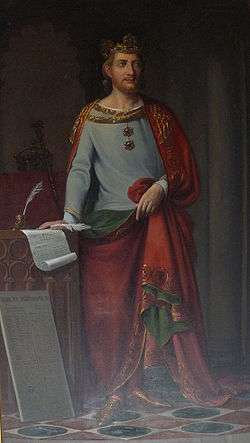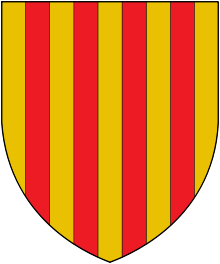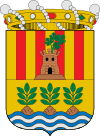Barony of Polop
| Barony of Polop and Benidorm (in Spanish, Señorío de la Baronía de Polop y Benidorm or simply, Señorío de Polop y Benidorm) | |
|---|---|
 | |
| Creation date | 13th century (±1268); Granted to the Fajardo de Mendoza family in the 15th century (1429) |
| Monarch | King Jaume I of Aragon |
| Peerage | Crown of Aragon |
| First holder | Doña Berenguela Alfonso of Castile and León |
| Remainder to | the 1st Baron's male (or female heirs since 1654) lawfully begotten |
| Subsidiary titles | Barony of Benidorm and Lordship of La Raya, La Ñora, Ávalos and Ceutí |
| The coat of arms of The Barons of Polop | |
|---|---|
| Information | |
| Motto | Ave Maria Gratia Plena, Latin for "Hail Mary Full of Grace" |
The Barony of Polop and Benidorm is an ancient Spanish hereditary lordship in the Kingdom of Valencia under the Crown of Aragon (in Spanish, baronía señorial aragonesa). The barony, including its castle and extensive land, is located in the province of Alicante, Valencia, Spain, only a few miles from the Mediterranean Sea.
After being possessed by the Crown of Aragon, in 1429 the barony was bestowed by King John II of Aragon, father of King Ferdinand of Spain the Catholic upon the Fajardo de Mendoza family. The most notable Barons of Polop are the Infantes of Aragon and Doña Beatriz Fajardo de Mendoza y Guzmán, Lady of Albudeyte. Other people associated with the Barony include the Castilian nobleman Don Rodrigo Díaz de Vivar, better known as El Cid Campeador.
History

Its origins date back to the conquest of Hispania by the Moors who occupied the Iberian Peninsula in the 10th century, when a fortress was built and named Polop.[1] In the 11th century, as it is related in the Historia Roderici ("History of Rodrigo"), El Cid Campeador occupied Polop Castle in 1089–1090 before conquering the city of Valencia in 1094.[2] Following his conquest of the Kingdom of Valencia, King James I of Aragon offered Polop Castle to the Muslim leader Mohammad Abu Abdallah Ben Hudzail al Sahuir until 1258 when the latter was defeated during a failed attempt against the life of the monarch.[3]
In the 13th century, Polop became a feudal barony[4] under the Charter of Sobrarbe.[5] In 1268 the barony was granted by King James I to his distant cousin, Berenguela Alfonso, who had become his concubine after his wife, Teresa Gil de Vidaure, allegedly developed leprosy, but returned to the Crown upon her death without issue.[6] In 1271 the King revived it for the knight Don Beltran de Bellpuig and, upon his death without issue, for Admiral Don Bernat de Sarrià.
During most of the 14th century the infantes of Aragon administered the lordship and were styled as Barons of Polop. In those years, Polop Castle continued being a strategic place to prevent the invasion of the large Muslim population.
Since the 15th century until the present days, the lordship has passed by personal descent through several generations of the Fajardo de Mendoza family and its heirs. It was on 17 December 1430 when the Infante John II of Aragon, King of Navarre through his marriage to Queen Blanche I of Navarre, granted it to his Lord-in-Waiting and Chamberlain Don Rodrigo Díaz de Mendoza and his heirs. Such grant was confirmed by his brother King Alfonso V of Aragon by Royal Charter of 1437. In 1727 King Philip V of Spain issued a Royal Charter allowing baronies in the Crown of Aragon to become titles of nobility in their own right. For instance, the Barony of la Pobadilla and the Barony of Bellpuig made use of such privilege in 1728 and 1923 respectively.
Following the abolition of the feudal system in the 19th century, Polop, like other Spanish feudal baronies and lordships, became obsolete but never extinct. In particular, the Abolition of Feudal Tenure (Spain) Act 1820 (Ley de Desvinculaciones de 1820) simply took away the legal and juridical rights pertaining to these lordships but preserved the property rights attached to them and the dignity of their honours including the right to use the feudal title and the coat of arms. In the present days, despite having no political power as such, lordships, like titles of nobility, simply remain rights held as prerogative of honour.
Jurisdiction
In the Low Middle Ages and until 1820, the Barony of Polop was a form of feudal land tenure according to the classic definition of feudalism, similar in some respects to the English feudal barony and the Scottish feudal lordship. It involved a set of reciprocal legal and military obligations among the warrior nobility. The baron was the nobleman who held the land or fief, including Benidorm, Chirles and La Nuncia, originally given by the king, and granted possession to the vassal in exchange for benefits, protection and other services. The Barons of Polop administered laws, waged war, established markets in towns, and maintained their own chanceries that kept their records. They also had their own deputies, or sheriffs and jurisdiction over all cases at laws sitting in their own courts. They could declare and wage war, establish boroughs, and grant extensive charters of liberties. They could confiscate the estates of traitors and felons, and regrant these at will. Finally, they could claim any and every feudal due, aid, grant, and relief. In contrast to titles of nobility in the Spanish peerage, no baronial relief was payable in order to lawfully take possession of the lordship.
The Barony of Polop is not to be confused with a manorial lordship in England and Wales. While manorial lordships can be sold, Polop, like other Spanish baronies, is hereditary in nature and under no circumstances can it be traded by the lineage family.
Those holding the lordship have held aristocratic rank and control over the land and been addressed and styled not only as lord but also as baron, as in the Crown of Aragon, lordships were called baronies, so namely, Lord of the Barony of Polop, Baron of Polop or simply Lord Polop (in Spanish, Señor de la Baronía de Polop, o shortly Barón de Polop or Señor de Polop).
Order of succession
Polop, like most other lordships, was hereditary in nature. In the Low Middle Ages and until 1654, it was only allowed to pass down by inheritance through the male line under Royal Charter of 1448. When Don Diego Fajardo de Mendoza y Guzmán died in 1643 without a male heir and with a sole sister, the Royal Audience of Valencia had to administer the lordship for 11 years until by Royal Charter of 1654 King Philip IV of Spain allowed it to be passed to an heir of either gender. Since then and until the present days, the barony has continued to be held by members of the Fajardo de Mendoza family and his blood relatives in the direct line of descent. Unlike titles of nobility in the Spanish peerage, each new baron is not required to be confirmed in the lordship by Royal Charter issued and signed by the monarch.[7]
As the Barons of Polop never made use of their right to let the lordship become a title of nobility under the Royal Charter of 1727 issued by King Philip V of Spain, Polop has remained a feudal barony with aristocratic rank. Therefore, following the enactment of the Abolition of Feudal Tenure (Spain) Act 1820, its transmission from generation to generation is not subject to the current revival legal provisions for titles of nobility but rather to the provisions of the original grants in the light of the Spanish historic law and the current civil procedure rules. In the 21st century, the rights of the holder of the barony should be confirmed by the Spanish courts of justice.
Armorial
| Figure | Name and blazon |
|---|---|
 |
Historic Coat of Arms of the Crown of Aragon |
 |
Following the wishes of Don Luis Fajardo de Mendoza y López de Ayala in 1593, the Shield was divided vertically with one half Fajardo and the other half Mendoza |
 |
In addition to the Lords of Polop, the family Fajardo included other prominent members such as Pedro Fajardo, Viceroy of Valencia, Navarre and Sicily, 5th Marquess of the Vélez and Grandee of Spain |
 |
The unofficial Arms of the municipality of Polop de la Marina display the arms of the Crown of Aragon and those of the Fajardo de Mendoza family. The Spanish Royal Academy of History proposed a different shield in 1990 but never approved.[8] |
The Barons of Polop
The first life holders in the Crown of Aragon
The lordship was first granted by King James I of Aragon to his cousin Berenguela Alfonso of Castile and León in 1268, and upon her death without issue, revived for the knight Beltrán de Bellpuig in 1271 and for Admiral Bernat de Sarrià in 1291.
| Holder | Period | |
|---|---|---|
| I | Doña Berenguela Alfonso of Castile | 1235 †1272 |
| II | Don Beltran de Bellpuig, Baron of Castellmontant and Lord-Lieutenant to King James I | |
| III | Don Bernat de Sarrià, Admiral and nobleman in the service of King James II of Aragon | 1266 †1335 |
The Infantes of Aragon as Royal Hereditary Barons of Polop
The Infantes of Aragon were styled as Barons of Polop during the Low Middle Ages until 1430.
| Holder | Period | |
|---|---|---|
| IV | Infante Don Pere of Aragon d'Anjou, Count of Ribagorça, Ampúries and Prades | 1305 †1381 |
| V | Infante Don Alfonso of Aragon Foix, Duke of Gandia and Count of Dénia and Ribagorça | 1305 †1381 |
| VI | Infante Don Alfonso of Aragon Arenós, Duke of Gandia and Count of Dénia | 1355 †1425 |
The Fajardo de Mendoza family as Hereditary Barons of Polop
In 1430 the Infante John II of Aragon, King of Navarre and Duke of Peñafiel and Montblanch, revived the lordship for his Lord-in-Waiting don Rodrigo Díaz de Mendoza, who died without male issue, and bequeathed it to his niece's husband Don Juan Alonso Fajardo and his heirs, the Fajardo de Mendoza family.
| Holder | Period | |
|---|---|---|
| VII | Don Rodrigo Díaz de Mendoza, Lord-in-Waiting to Infante John II of Aragon, King of Navarre[9] | †1447 |
| VIII | Don Juan Alonso Fajardo | |
| IX | Don Diego Fajardo y Díaz de Mendoza | †1494 |
| X | Don Alonso Fajardo de Mendoza y Heredia | †1530 |
| XI | Don Alonso Fajardo de Mendoza y Soto | 1491 †1562 |
| XI | Don Luis Fajardo de Mendoza y López de Ayala | †1593 |
| XII | Don Pedro Fajardo de Mendoza y López de Ayala | |
| XIII | Don Alonso Fajardo de Mendoza y Fajardo de Medina[10] | †1622 |
| XIV | Don Juan Fajardo de Mendoza y de la Cueva | 1583 †1622 |
| XV | Don Alonso Fajardo de Mendoza y Guzmán | †1637 |
| XVI | Don Diego Fajardo de Mendoza y Guzmán | †1643 |
| XVII | Doña Beatriz Fajardo de Mendoza y Guzmán, Lady of Albudeyte | 1619 †1678 |
| XVIII | Don Gaspar de Puixmarín y Fajardo de Mendoza[11] | 1654 †1687 |
| XIX | Don José Rodrigo Baltasar de Puxmarín y Fajardo de Mendoza, Marquess of Albudeyte[12] | 1691 |
| XX | Doña Josefa de Puixmarín y Fajardo de Mendoza, Countess of Montealegre | 1716 †1791 |
| XXI | Doña María Antonia Teijeiro de Valcárce y Puxmarín, Marchioness of Albudeyte, Grandee of Spain | 1754 †1805 |
| XXII | Doña Ana Agapita de Valda y Teijeiro de Valcárce, Marchioness of Albudeyte, Grandee of Spain | 1781 †1854 |
Usage following the abolition of feudal tenure in Spain in the 19th century
Post-1820, there is evidence in the archives of the Spanish Royal Academy of History that the following descendants of the Fajardo de Mendoza family were called to the title of honour of Barón de Polop and the use of the Arms of the barony.:[13]
| Holder | Period | |
|---|---|---|
| XXIII | Don José Eusebio Bernuy y Valda, Marquess of Valparaíso | 1804 †1856 |
| XXIV | Don Francisco de Paula Bernuy y Osorio de Moscoso, Marquess of Valparaíso | 1824 †1875 |
| XXV | Doña María Bernuy y Osorio de Moscoso, Marchioness of Valparaíso and Marchioness of Villafuerte | 1830 †1899 |
Following the death of Doña María Bernuy y Osorio de Moscoso in 1899, the barony has been represented by Lord Julian Benito Lopez-chavarri y Febrero, a descendant of the Fajardo de Mendoza family.[14]
Barons of Polop
Infantes of Aragon is an appellation commonly used by Spanish historians to refer to a group of infantes (princes) of the House of Trastámara in the 15th century.
Admiral Don Bernat de Sarrià
Doña Beatriz Fajardo de Mendoza y Guzmán also inherited the lordship of Benidorm, a half-destroyed town, depopulated, that had lost its category of municipality after having been absorbed by Polop. But in 1666 the baroness repopulated Benidorm, granted a new Puebla Letter to it and established limits for the municipality very similar to the existing ones today. By guaranteeing the supply of water through the construction of the Reg Major of l'Alfàs, she transformed Benidorm into an economically viable city, the embryo of the present city.[15] By deed granted in April 1666 in Polop Castle, the baroness also founded the Nou Reg to irrigate 1,207 hectares of land.[16] She lived an eventful life.
Location
The municipality of Polop is located in the province of Alicante, Valencia, Spain, only a few miles from the Mediterranean Sea.[17]
See also
References
- ↑ Fuster Pérez, Joaquín. Baronía de Polop, Ayuntamiento de Polop de la Marina, Polop de la Marina, 1992.
- ↑ Der Islam. Al-Azraq's Surrender Treaty with Jaume I and Prince Alfonso in 1245.
- ↑ Burns, Robert I. S.J. "The Crusade against Al-Azraq: A Thirteenth-Century Mudejar Revolt in International Perspective" in the The American Historical Review, Vol. 93, No. 1, The University of Chicago Press on behalf of the American Historical Association, February 1988.
- ↑ Madramaní Calatayud, Mariano. Tratado de la Nobleza de la Corona de Aragón, Valencia, 1787.
- ↑ Giesey, Ralph E. If not, not. The Oath of the Aragonese and the Legendary Laws of Sobrarbe, Princeton, New Jersey, 1968.
- ↑ Delgado, Angel y Dieste, José Damian. El Rey Conquistador: La Crónica Oculta de Jaime I, Edhasa, Barcelona, 2008.
- ↑ Orts, Pere María y Amillo, Francisco. "Los Señores de Polop" (Siglos XV- XIX), Festes del Porrat, Ayuntamiento de Polop de la Marina, Polop de la Marina, 2007.
- ↑ Proposal coat of arms of Polop de la Marina by the Royal Spanish Academy.
- ↑ López Rodríguez, Carlos. Nobleza y Poder Político en el Reino de Valencia: 1416–1446, Pubücacions de la Universitat de Valencia, Valencia, 2005.
- ↑ Losa Serrano, Francisco Javier. El Señorío de Montealegre, Ediciones de la Universidad de Castilla-La Mancha, 1998.
- ↑ Catalá Sanz, Jorge Antonio. Rentas y Patrimonios de la Nobleza Valenciana en el Siglo XVIII, Siglo XXI Editores.
- ↑ Cárdenas Piera, Emilio (de) and Cadenas y Vicent, Vicente (de). Caballeros de la Orden de Santiago, Siglo XVIII, Hidalguía, Madrid, 1996.
- ↑ El Marqués de Siete Iglesias. Boletín de la Real Academica de la Historia, Tomo CLXXI. Número III, Madrid, 1974.
- ↑ Sebastián Elián, Juan. El Gran Libro de los Apellidos y la Heráldica, Ediciones Robinbook, Barcelona, 2001.
- ↑ Amillo Alegre, Francisco. Beatriu Fajardo de Mendoza, I La Carta de Poblament de Benidorm (1666), Benidorm, 2003.
- ↑ Yáñez, Antonio. Historia y Descripción de Benidorm, Gráficas Díaz, Alicante, 2000.
- ↑ Consellería de Cultura, Educació i Esport – Direcció General de Patrimoni Cultural Valencià y Paisajes Españoles, Generalitat Valenciana.
External links
- Spanish National Historical Archive, Section of Nobility
- Royal Archives of the Kingdom of Valencia
- Castles of Spain
- Biblioteca Virtual de Derecho Aragonés
- Instituto Beatriz Fajardo de Mendoza
Coordinates: 38°37′20″N 0°07′38″W / 38.62222°N 0.12722°W